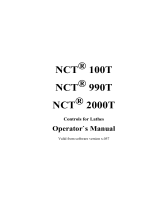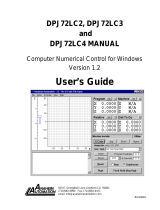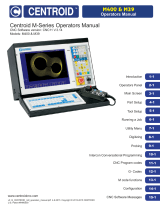
Operating manual.
Quercus
CNC 8060
CNC 8065
·7·
REF. 2005
16.6.1 Softkey menus. ........................................................................................................ 309
16.6.2 Changing the tool of the spindle............................................................................... 309
16.7 Table for the status of the tool change process ........................................................... 310
16.8 Magazine table............................................................................................................. 311
16.8.1 Softkey menus. ........................................................................................................ 312
16.8.2 List of magazine positions........................................................................................ 313
16.8.3 Magazine information............................................................................................... 314
16.9 Operations with the magazine table............................................................................. 316
16.9.1 Loading / unloading tools to / from the magazine .................................................... 316
16.9.2 Load / unload a tool to / from the tool changer arm ................................................. 318
CHAPTER 17 UTILITIES MODE
17.1 Interface description..................................................................................................... 319
17.1.1 Softkey menus. ........................................................................................................ 321
17.2 Set how to display the list of programs. ....................................................................... 322
17.3 Select files and create folders...................................................................................... 323
17.4 Find in files................................................................................................................... 324
17.5 Protection passwords................................................................................................... 325
17.6 Data safety backup. Backup - Restore ........................................................................ 327
17.7 Encrypting files............................................................................................................. 329
CHAPTER 18 PLC
18.1 Appearance of the PLC mode...................................................................................... 331
18.1.1 Icon description (vertical softkeys) ........................................................................... 332
18.2 "Programs" service ...................................................................................................... 333
18.2.1 Softkey menus. PLC project..................................................................................... 334
18.2.2 Softkey menus. Files of the PLC project. ................................................................. 335
18.3 Program editing............................................................................................................ 336
18.4 Editing in C language or mnemonic language. ............................................................ 338
18.4.1 Softkey "Analyze"..................................................................................................... 339
18.4.2 Softkey "File". .......................................................................................................... 339
18.4.3 Softkey "Undo". ........................................................................................................ 339
18.4.4 Softkey "Operations with blocks". ............................................................................ 340
18.4.5 Softkey "Find/Replace". ........................................................................................... 341
18.4.6 Softkey "Customize"................................................................................................. 342
18.5 Editing in contact (ladder) language (softkeys)............................................................ 343
18.5.1 Softkey "Analyze"..................................................................................................... 344
18.5.2 Softkey "File". .......................................................................................................... 344
18.5.3 "Edit" softkey. .......................................................................................................... 345
18.5.4 Softkey "View". ........................................................................................................ 347
18.5.5 Softkey "Marks". ...................................................................................................... 347
18.5.6 Softkey "Find"........................................................................................................... 348
18.5.7 Softkey "Customize"................................................................................................. 348
18.6 Program monitoring ..................................................................................................... 349
18.6.1 Softkey menus. Monitoring in C language or mnemonic language. ........................ 350
18.6.2 Softkey menus. Monitoring in contact (ladder) language. ....................................... 351
18.7 "Commands" service.................................................................................................... 353
18.7.1 Softkey menus. Options of the "Commands" service............................................... 353
18.8 "Outputs" service ......................................................................................................... 354
18.8.1 Softkey menus. Options of the "Outputs" service. ................................................... 355
18.9 "Logic analyzer" service............................................................................................... 356
18.9.1 Editing logic analyzer data ....................................................................................... 357
18.9.2 Save, load and reset the analyzer configuration ...................................................... 359
18.9.3 Execute and analyze trace....................................................................................... 360
18.9.4 Customize the appearance of the logic analyzer ..................................................... 360
18.10 "Monitoring" service ..................................................................................................... 361
18.10.1 Description of resource tables.................................................................................. 362
18.10.2 Definition of the table resources............................................................................... 363
18.10.3 Options of the "Monitoring" service (softkeys). ........................................................ 364
18.11 "Cross references" service........................................................................................... 365
18.11.1 Softkey menus. Options of the "Cross reference" service. ...................................... 366
18.12 "Statistics" service........................................................................................................ 367
18.12.1 Softkey menus. Options of the "Statistics" service................................................... 368
18.13 "Messages" service...................................................................................................... 369
18.13.1 Softkey menus. Options of the "Messages" service................................................. 370
18.13.2 Editing the message and error table ........................................................................ 371
18.13.3 Displaying PLC messages ....................................................................................... 372
18.13.4 Displaying PLC errors .............................................................................................. 373
18.13.5 Grouping the additional information text files in a single file. ................................... 374
18.13.6 Save, load and print a message and error table ...................................................... 375






















